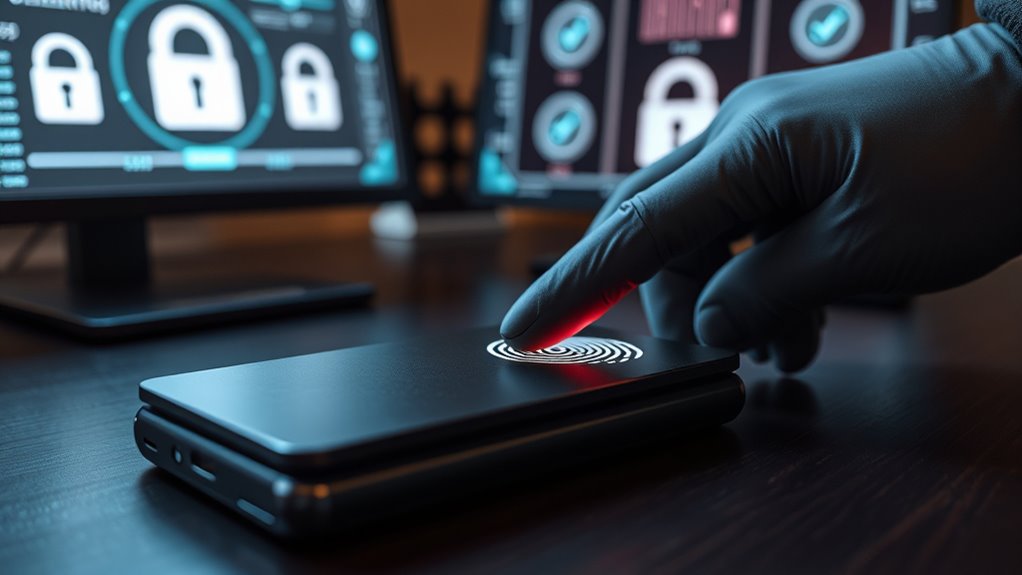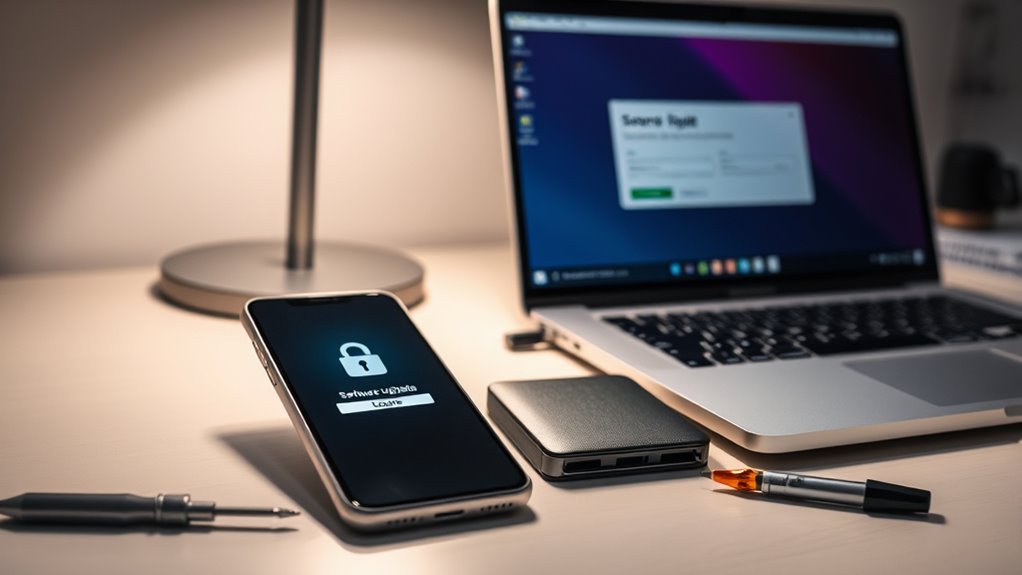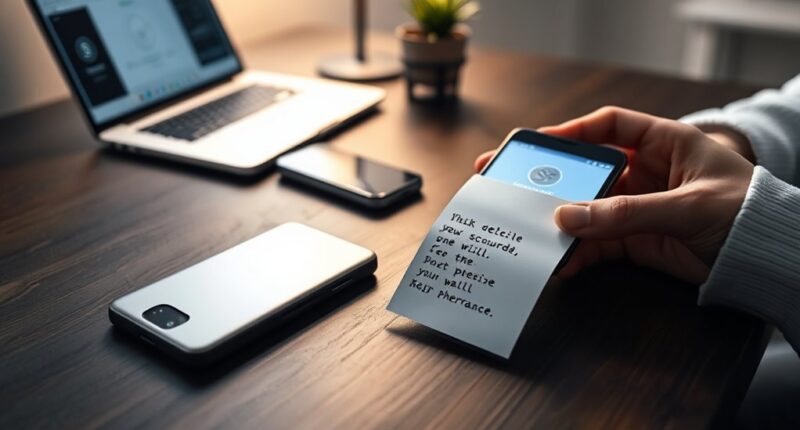To secure your cryptocurrency, choose the right wallet type—cold storage for long-term, hardware wallets or paper wallets, and hot wallets for quick trades—while keeping private keys offline and backed up securely. Enable two-factor and biometric authentication, use strong passwords, and keep your wallet software and hardware up to date. Store physical wallets safely, limit access, and monitor activity regularly. Continue exploring these tips to build a thorough security strategy that keeps your assets safe.
Key Takeaways
- Use cold wallets like hardware or paper wallets for long-term storage and keep private keys offline.
- Enable two-factor authentication and biometric security to protect wallet access.
- Regularly update wallet software and firmware from official sources to patch vulnerabilities.
- Back up private keys in multiple secure, offline locations; never share or expose them.
- Limit access privileges and perform routine security reviews to detect suspicious activity.
Choosing the Right Wallet Type for Your Needs

Choosing the right cryptocurrency wallet depends on how you plan to use and store your assets. If you frequently trade or need quick access, a hot wallet offers convenience but carries higher security risks. For long-term storage or large holdings, cold wallets like hardware or paper wallets provide better protection by keeping private keys offline. Hardware wallets, such as Ledger Nano or Trezor, are ideal for secure, portable storage, especially if you’re tech-savvy. Paper wallets can be secure too but require careful handling and multiple backups to prevent physical loss or damage. Multi-signature wallets add an extra layer of security by requiring multiple approvals for transactions, suitable for managing shared accounts or high-value assets. Understanding the importance of contrast ratio can help you choose hardware with better display quality for reviewing your transaction details clearly. Choose based on your balance of convenience and security needs.
Best Practices for Managing Private Keys

Managing private keys effectively is the foundation of securing your cryptocurrency assets. You must never share, photograph, or expose them to others; possession means control. Use hardware wallets or cold storage options like hardware or paper wallets for large amounts, keeping private keys offline. Always back up your keys in multiple secure locations, ensuring they’re physically protected from damage, theft, or loss. Avoid reusing the same private key across different wallets or transactions, as this increases vulnerability. Employ strong, unique passwords and enable encryption for any stored keys. Regularly verify the integrity of your backups and restrict access to trusted individuals. Remember, losing your private key means losing access to your funds permanently—treat your keys with the highest security standards at all times. Proper key management is essential for maintaining the security and integrity of your cryptocurrency holdings.
Enhancing Security With Authentication and Access Controls

Implementing strong authentication methods and strict access controls is essential to safeguarding your cryptocurrency wallets. Enable two-factor authentication (2FA) on all accounts, preferably using authenticator apps instead of SMS, to prevent SIM-swaps. Use biometric authentication, like fingerprint or face ID, where supported, for quick yet secure access. Choose strong, unique passwords (16+ characters), and manage them with a reputable password manager. Limit access privileges to only those who need it, following the principle of least privilege. Regularly review access logs for suspicious activity or unauthorized attempts. These measures add multiple layers of security, making it harder for attackers to gain unauthorized access. By controlling who can access your wallets and how, you profoundly reduce the risk of theft or compromise. AI security measures are increasingly important as digital assets become more targeted by cyber threats.
Keeping Wallet Software and Hardware Up to Date

Keeping your wallet software and hardware up to date is crucial for maintaining security. Updates patch vulnerabilities, fix bugs, and improve overall protection against cyber threats. Failing to keep everything current leaves you exposed to known exploits.
Stay vigilant with these steps:
- Enable automatic updates to ensure you never miss critical patches.
- Download software only from official sources to avoid malware-infected versions.
- Update firmware on hardware wallets regularly, so your device defends against emerging threats.
Ignoring updates can result in breaches, lost funds, or compromised private keys. Regularly checking for new versions keeps your wallet resilient against hackers and exploits. Think of updates as essential armor—necessary to defend your assets effectively.
Physical and Procedural Measures to Protect Your Crypto Assets

Securing your crypto assets requires more than just digital safeguards; physical and procedural measures are essential to prevent theft, damage, or loss. You should store hardware and paper wallets in secure locations like safes or bank vaults, and keep multiple copies in different places. Regularly verify and update your backup copies to ensure they remain accessible and intact. Implement remote wipe capabilities on devices to erase data if stolen, and conduct background checks on anyone with wallet access to prevent insider threats. When choosing wallet providers, perform due diligence to confirm their trustworthiness. Additionally, staying informed about security best practices can help you adapt to evolving threats.
Frequently Asked Questions
How Do I Recover My Wallet if I Lose My Backup Phrase?
If you lose your backup phrase, recovering your wallet becomes nearly impossible. You can’t access your funds without it because it’s the only way to restore your private keys. To prevent this, always create multiple secure copies of your backup phrase and store them in separate, safe locations. Avoid sharing or exposing it to others. Without the phrase, your funds are permanently inaccessible, so safeguard it diligently.
What Are the Risks of Using Third-Party Wallet Services?
Using third-party wallet services can expose your funds to several risks. You might face theft if the service gets hacked or experiences a security breach. There’s also the danger of losing access if the provider shuts down or mismanages your keys. Additionally, you depend on their security measures, which may not be as robust as cold storage options. Always research providers carefully and consider keeping large amounts in more secure wallets.
How Can I Securely Share Wallet Information With Trusted Parties?
You should only share wallet information with trusted parties and do so securely. Use encrypted communication channels like PGP email or secure messaging apps to protect sensitive data. Never share private keys or seed phrases openly—consider using multi-signature wallets that require multiple approvals. Always verify the recipient’s identity beforehand, and avoid sending details over unsecured networks or via email, which can be intercepted.
Are There Specific Security Measures for Mobile Wallets?
You should enable biometric authentication like fingerprint or face ID on your mobile wallet for quick yet secure access. Always keep your app updated to patch security vulnerabilities. Use strong, unique passwords and activate two-factor authentication when available. Avoid public Wi-Fi during transactions and consider encrypting your device. Regularly monitor your wallet activity, and back up your wallet’s seed phrase securely offline to prevent loss.
What Should I Do if I Suspect My Wallet Has Been Compromised?
If you suspect your wallet’s been compromised, act fast—like a firefighter racing to a blaze. Immediately transfer your remaining funds to a secure, cold wallet, cutting off the thief’s access. Change all passwords, enable two-factor authentication, and scan your device for malware. Notify your wallet provider, and consider resetting or replacing compromised hardware. Vigilance now can be the shield that protects your hard-earned assets from irreversible loss.
Conclusion
By following these tips, you’ll build a fortress around your crypto assets, turning your wallet into a vault you control. Remember, staying vigilant is like watering a plant—you need to nurture your security habits consistently. Keep your software updated, use strong authentication, and store your private keys carefully. With these practices, you’ll navigate the crypto world confidently, knowing your investments are as safe as a treasure chest buried deep underground. Stay secure and keep your crypto safe!









